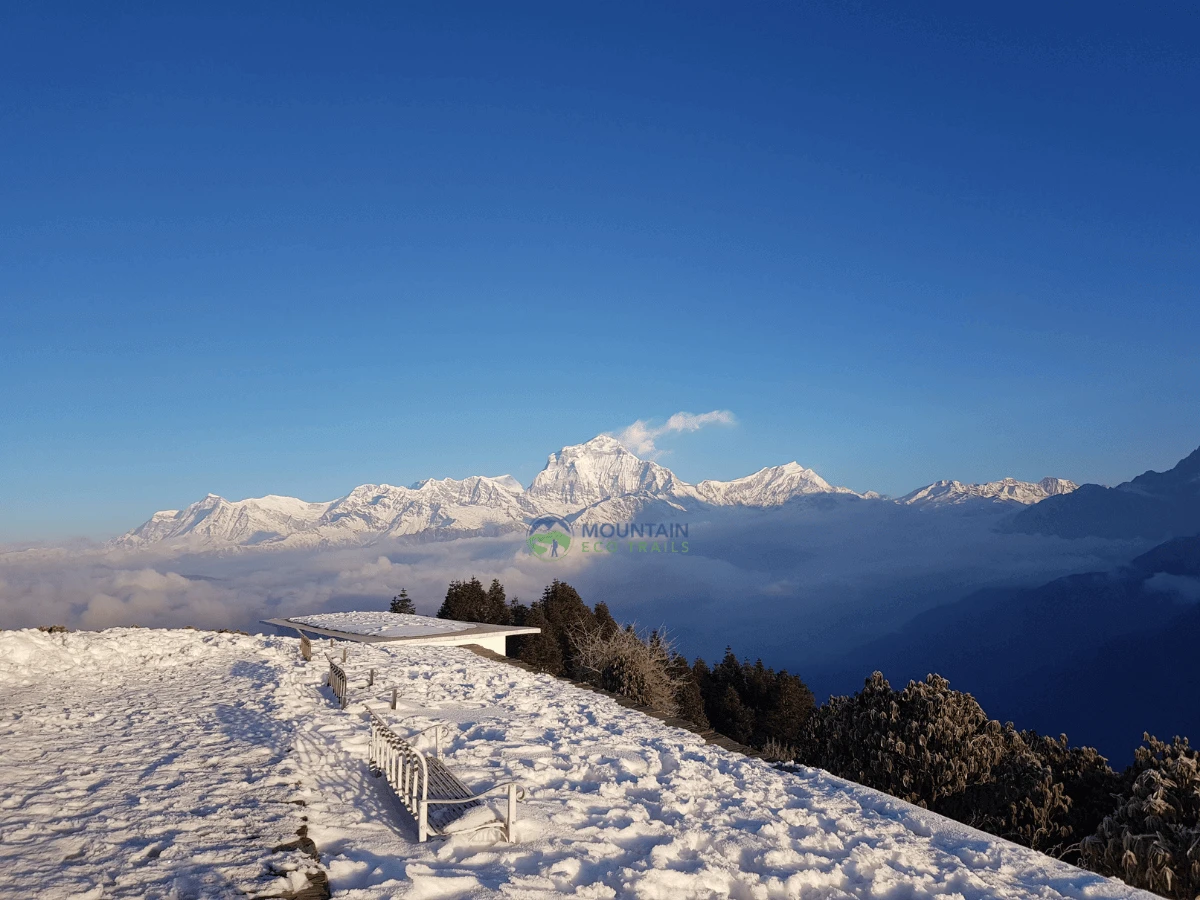What to Expect on the 3-Day Poon Hill Trek
The 3-day short Poon Hill Trek is the best short treks in Nepal for its incredible mountain views. This trek takes you through charming villages, lush rhododendron forests, and reaches a stunning panoramic viewpoint at Poon Hill (3,210 m) in just 3 days. The trek to Ghorepani Poon Hill offers an authentic taste of the Annapurna Region and its breathtaking beauty. The trekking trail of the Ghorepani Poon Hill is beginner-friendly.
The trek goes through Gurung and Magar villages and terrace farmlands. As you ascend, dense forests of oak and rhododendron surround the trail. If you trek in spring, the hillsides burst into red and pink blooms.
Upon reaching Ghorepani village (around 2,850 m), you’re already greeted with glimpses of snow-capped peaks. But the real payoff comes with the pre-dawn hike on Day 3 to Poon Hill summit, where a 360° Himalayan panorama awaits. You’ll see giants like Annapurna I (8,091 m) and Dhaulagiri (8,167 m) on full display, among many other peaks. Despite being a short trek from Pokhara, the Poon Hill journey offers rewards on par with longer Annapurna treks – truly a short trek from Pokhara that punches above its weight in scenery.
Sunrise from Poon Hill: The Highlight of This 3-Day Trek from Pokhara
The sunrise from Poon Hill is the highlight of the trek and one of the best short treks for witnessing the sunrise in Nepal. On the third morning, you’ll wake before dawn in Ghorepani and hike to Poon Hill for the Sunrise View.
When you arrive at the Poon Hill viewpoint, you’ll witness Annapurna South (7,219 m) and Machhapuchhre (6,993 m, the Fishtail)– Annapurna I, Annapurna II, III, IV, Hiunchuli, Nilgiri, Tukuche Peak, and even far-off peaks like Manaslu (8,163 m) can be visible. The Poon Hill Sunrise Trek is famous for this moment: a jaw-dropping 360° Himalayan panorama.
3-Day Poon Hill Trek vs. 4-Day Ghorepani Trek – Which One to Choose?
Trekkers often wonder whether to do the 3-day Poon Hill Trek or the 4-day Poon Hill Trek. Both options follow a similar route to the Poon Hill viewpoint. The 4-day Ghorepani Poon Hill trek is essentially a more relaxed version of the journey. In contrast, the 3-day short Poon Hill trek is more hectic; you’ll be trekking a longer distance on Day 3 to return to Pokhara. If you have limited time, the 3-day trek is a fantastic choice to hit the highlights.
Likewise, both Ghorepani Poon Hill Itineraries start from Nayapul and go up to Ghorepani and Poon Hill. The 4-day trek often follows a circular route via Ulleri to Ghorepani, then, after Poon Hill, continuing to Tadapani and down to Ghandruk. The 3-day trek will hike up to Poon Hill and retrace the same route back to Ulleri and then drive back to Pokhara by Jeep or Car from Nayapool.
Alternatives: If you’re interested in similar treks in the area, an excellent alternative is the Mohare Danda Trek. This route, often 5–7 days but with options as short as 3–4 days, takes you to Mohare Danda (3,300 m), which offers equally breathtaking sunrise panoramas of Annapurna and Dhaulagiri.
How Much Does the 3-Day Poon Hill Trek Cost?
One of the appeals of the Poon Hill trek is that it is relatively affordable compared to longer treks. The Poon Hill Trek cost for 3 days will vary based on the services you choose. The standard cost of the Poon Hill Trek starts from USD 499 and reaches up to USD 599 per person. However, the 3-day Poon Hill Trek costs range from USD 399 per person for the whole package. Mountain Eco Trails provides an inclusive 3-day Poon Hill Package cost with meals, accommodation, guide, transportation, and other logistical arrangements with no hidden costs.
Choose Mountain Eco Trails for this Short 3-day Poon Hill Trek Itinerary from Pokhara
Choosing the best local trekking company is always crucial while planning your trek into the Himalayas. Mountain Eco Trails has been organizing this Ghorepani Poon Hill Trek along with other popular treks in Nepal with a team of experts. Here are the reasons why you should choose us for this trek:
- An expert and experienced guide who can lead you to the destination with all the safety precautions.
- Flexible and customised Itinerary based on the preference of the trekkers.
- Complimentary services like Duffel Bag, Trekking Poles, and SIM Card.
- Basic First Aid Kit for emergencies.
- Hassle-free last-minute bookings.
- Fair and Competitive price with no hidden cost.
Want to know more about the Poon Hill Trek 3 Days? Feel Free to contact us via email or WhatsApp at +9779849790153.






